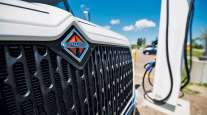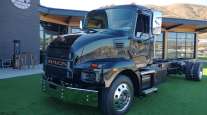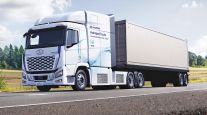Contributing Writer
Availability of Medium-Duty E-Trucks Is Limited as Testing Continues
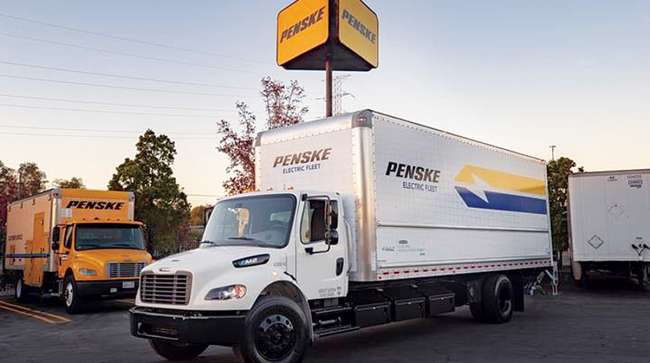
[Stay on top of transportation news: Get TTNews in your inbox.]
Battery-electric medium-duty trucks may have a bright future due to their potential to reduce operational costs and improve sustainability. But currently, the availability of these trucks is limited as testing continues.
UPS Inc. would like to purchase more electric vehicles, said Scott Phillippi, senior director of maintenance and engineering, but sufficient production units are not available. In fact, he had just left a meeting with a manufacturer before an interview with Transport Topics.
“Waiting for electric vehicles is like seeing the sign at the bar that says, ‘Free beer tomorrow,’ ” he said. “I know it’s not easy, but we’re waiting again for something to hit the market that really sets the tone and the benchmark of what ‘good’ is going to look like.”
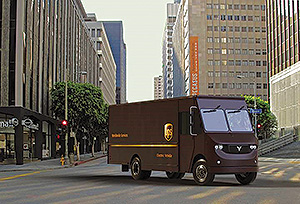
Shown is an artist's rendering. UPS is collaborating with Xos to develop an electric Class 6 delivery truck in Los Angeles. (UPS)
UPS has about 371 electric trucks, most of them medium-duty, in its worldwide fleet, Phillippi said. UPS ranks No. 1 on the Transport Topics Top 100 list of the largest for-hire carriers in North America.
Last October, the North American Council for Freight Efficiency issued a report concluding that electric trucks are a viable alternative for Classes 3-6 trucks in urban settings with freight hauls of less than 100 miles. Another study, by UPS and GreenBiz Group, found that electric medium-duties could be deployed for the same cost as diesel vehicles.
In an interview this month with Transport Topics, NACFE Executive Director Mike Roeth said electrification is a better fit for medium-duty trucks than heavy-duty. Intracity trucks can charge easily during overnight dwell times, have dedicated routes and stay close to home near maintenance professionals.
Roeth said electric trucks’ upfront cost is not as big of an increase over diesel trucks as many might expect because the battery for a 75-miles-a-day truck isn’t that large. Also, electric trucks can be designed more creatively for entrance and egress.
“A year from now, we’ll be able to talk more specifically about the results of some of these electric trucks,” he said. “This is not a fad. It’s not going away. It’s really happening.”
At the Advanced Clean Transportation Expo earlier this year, Daimler Trucks North America CEO Roger Nielsen said, “I believe the future is electric.”
Electric vehicles are coming, particularly in the light- and medium-duty sectors, and especially for final-mile fleets, said Jack Legler, technical director of the Technology & Maintenance Council, a council of American Trucking Associations.
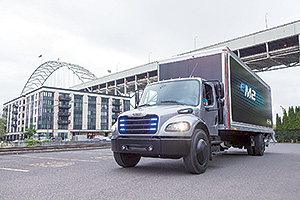
An eM2 medium-duty electric truck from Freightliner Trucks, a division of Daimler Trucks North America. (Daimler Trucks North America)
One advantage of electric trucks is a simpler vehicle architecture. Classes 6-8 battery-electric trucks have about 8,000 moving parts, compared with 30,000 for diesels, according to DTNA.
In fiscal 2018, FedEx Corp. added 455 electric vehicles, giving it more than 2,554 in all sizes in service. That includes forklifts, airport ground service equipment and delivery vehicles.
By May 2020, the company expects to add 1,000 Chanje V8100 electric vans to its Express fleet in California, said Bill Cawein, FedEx Express manager of technology and integration. The company is finding electric vehicles work better in temperate climates because cold weather reduces range.
E-commerce is one driver of the increasing use of electric vehicles because they can reduce operational costs, Cawein said. While the cost remains high, government incentives and grant programs can help them equal diesels. Increasing volumes will bring down the cost “significantly” by 2025, he said.
FedEx ranks No. 2 on TT’s Top 100 list of for-hire carriers.
Another possible early adopter is the U.S. Postal Service, which is testing the technology along with other alternative engines and drivetrains in a multiyear process. USPS has deployed 15 electric vans in both Stockton and Fresno, Calif.
Kim Frum, senior public relations representative, said that in 2017, USPS purchased 50 Lightning Systems hydraulic hybrid and 50 XL-brand hybrid-electric medium-duty trucks.
Amazon.com, meanwhile, has set a goal of reaching 50% of all shipments having net-zero carbon by 2030, a company spokesperson said. That goal involves “anticipated and continued progress in electric vehicles.”
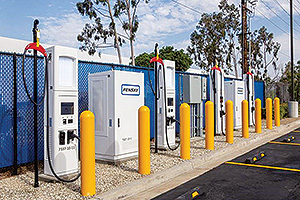
A Penske commercial electric-vehicle charging station in La Mirada, Calif. (Penske Truck Leasing)
Penske Truck Leasing is conducting short-distance test cases with 10 medium-duty Freightliner eM2s in California, said Paul Rosa, senior vice president of procurement and fleet planning. The fleet has installed a total of 14 high-speed chargers at four facilities. It plans to add at least six more chargers. The vehicles are being maintained alongside diesel vehicles with specialized tools and trained technicians.
It’s too soon to report what has been learned with its pre-production units.
“We need to log more miles over the road in multiple customer scenarios to provide meaningful insights,” he said.
Reading, Pa.-based Penske Logistics ranks No. 16 on the for-hire TT Top 100.
Meanwhile, Phillippi said UPS’ electric vehicles have performed well in the field and have been able to go everywhere that diesels have gone, just not as far. While lessons have been learned, no failures have occurred, and there has been no reason to change direction away from electrification.
As trucks become available, UPS will expand their use.
“What we’ve learned is we want to put them in an environment to be successful and then stretch the boundaries from there,” he said.
As the trucks become more broadly available, Phillippi said it could take the industry several years to work out the kinks, as was the case with trucks powered by compressed natural gas.
“You want to do what makes sense, and you definitely want to be in the lead, not trying to keep up,” he said.

Nielsen
In his speech at ACT Expo, DTNA’s Nielsen said the company had nearly 50 battery-electric trucks running and delivering freight, but acknowledged that more work will be needed to enhance these vehicles’ return on investment.
“Unfortunately, there is no business case today for a sane and sober customer to buy a battery-electric truck,” he said.
While Nielsen said the future is electric, government incentives are needed now. For medium- and heavy-duty electrics, the cost per battery measured in dollars per kilowatt hour must be cut in half, density must be doubled to reduce the weight of batteries and volume metric size measured in kilowatt hours per liter must be reduced by half.
The industry also still lacks universal charging standards.
The internal combustion engine network was created over a period of decades, while the electrification infrastructure still is forming, said Rob Massoudi, global vice president of digital transformation at ABB, which said it has the world’s largest installed base of electric-vehicle chargers.
Fleets that want to purchase electric vehicles must consider, among other factors, their plan for growth and their strategy for rollout, Massoudi said. Some car rental agencies bought Teslas and installed charging stations without taking into account peak load demand and charges. The result was unexpected, sky-high electric bills.
“We see the next three to five years are going to be the golden years of adoption in electric vehicles provided that … regulatory policy continues to move at an aggressive pace,” Massoudi said.
He added that many trends such as battery costs are moving in the right direction. The wild card is public policy, which could accelerate or decelerate the process. Most major European cities have zero-emissions zones.
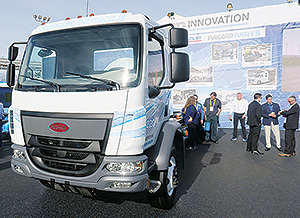
An all-electric, medium-duty Peterbilt Model 220 EV truck on display. (Seth Clevenger/Transport Topics)
Peterbilt Motors Co., meanwhile, has three working models of its medium-duty 220EV and is getting them in the hands of demonstration fleets.
Wesley Slavin, Peterbilt’s on-highway marketing manager, said the company is being selective to ensure those fleets’ applications match the vehicle and the route is conducive with the charging infrastructure.
The company plans to move to low-volume production in the next year or two. The manufacturer also is making its Class 8 579 day cab and its Class 8 520 refuse truck available as electric vehicles.
Electric vehicles are beginning to be a viable alternative to diesel over a 10-year cycle for customers who have “a little bit of grant money,” Slavin said. Vehicles have been built with help from California and the federal government. Slavin described California’s efforts as “pretty dramatic.”
“One of the messages that we communicated in our annual dealer meeting earlier this year was, if you’ve got a dealership in the state of California or nearby there, that we would recommend you get educated on electrification and possibly putting in charging stations at your dealership because we think it’s coming to a dealership near you, and you should be a leader in this space,” he said.
Ultimately, electric trucks will need to become competitive with diesel trucks without the help of grant money. Motor carriers want to be environmentally sustainable, but they also must make a profit.
“It’s still, the bottom line is the bottom line,” TMC’s Legler said. “Because if you, out of the goodness of your environmental heart, go and do all this stuff and you make yourself noncompetitive, those trucks are going to sit because you’re not going to be able to use them to efficiently transport cargo.”


